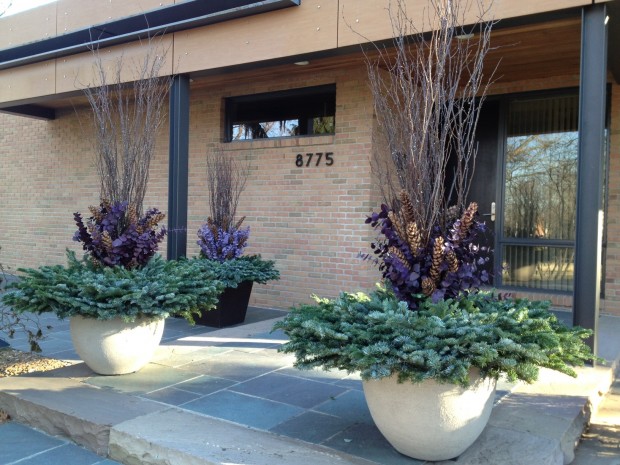
purple and lavender
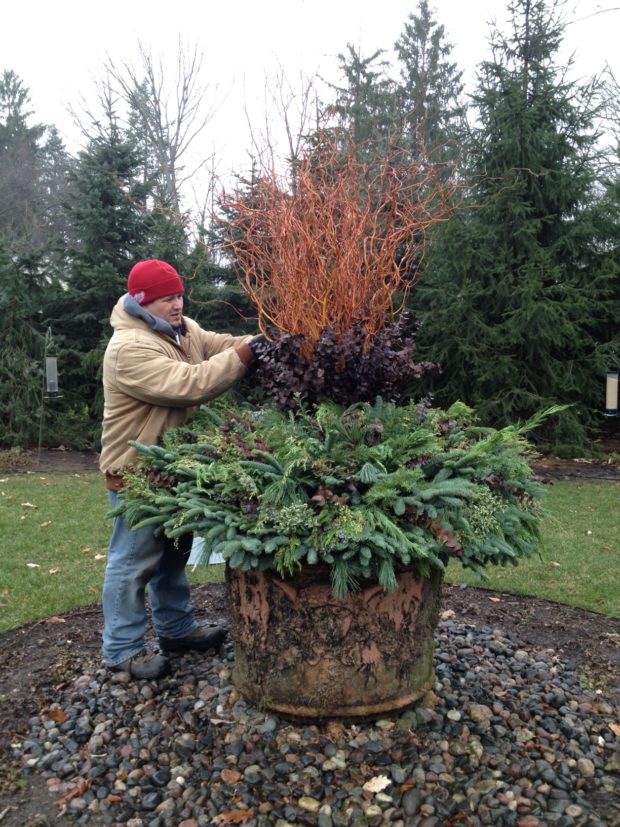 Dressing a fountain for winter
Dressing a fountain for winter
 Francesca del Re terra cotta pot ready for winter
Francesca del Re terra cotta pot ready for winter
 blanket of noble and silver fir
blanket of noble and silver fir
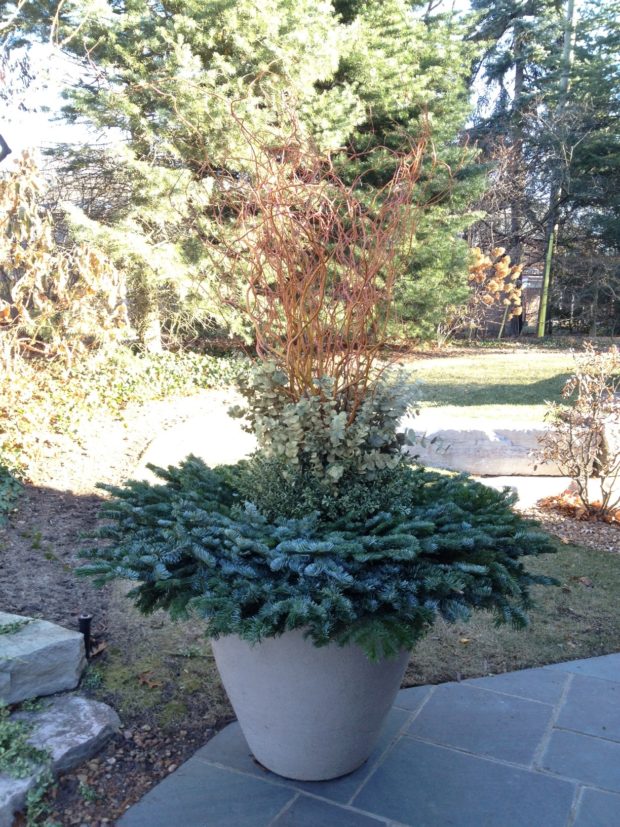 curly copper willow and oregonia
curly copper willow and oregonia
 red bud pussy willow, mixed greens, fan willow, and purple eucalyptus
red bud pussy willow, mixed greens, fan willow, and purple eucalyptus
Deborah Silver is an accomplished and experienced landscape and garden designer whose firm first opened its doors in 1986.

purple and lavender
 Dressing a fountain for winter
Dressing a fountain for winter
 Francesca del Re terra cotta pot ready for winter
Francesca del Re terra cotta pot ready for winter
 blanket of noble and silver fir
blanket of noble and silver fir
 curly copper willow and oregonia
curly copper willow and oregonia
 red bud pussy willow, mixed greens, fan willow, and purple eucalyptus
red bud pussy willow, mixed greens, fan willow, and purple eucalyptus
 Part 3 of my tutorial about the construction of winter containers has to do with bringing the special details to life. Evergreens stuck into a foam form the base of the winter container. A structure upon which to build. A centerpiece, no matter whether it is tied up tight and of a piece, or stuck individually, provides an element upon which to focus. Up next-the details.
Part 3 of my tutorial about the construction of winter containers has to do with bringing the special details to life. Evergreens stuck into a foam form the base of the winter container. A structure upon which to build. A centerpiece, no matter whether it is tied up tight and of a piece, or stuck individually, provides an element upon which to focus. Up next-the details.
 A blank canvas can be lush in and of itself, but it asks for those details that make for an individual design. The third element of any winter pot-those thoughtfully constructed and expressed finishing details. Pistou is a vegetable soup of French origin, , made with vegetables, various beans, and small macaroni. This is an overview- their are many individual recipes. Upon serving, the soup is topped with a large dollop of basil pesto which is showered with grated parmesan cheese. The addition of the pesto and its parmesan is an individually imagined finish. Pistou has no end of recipes, should you look it up on line. Individual chefs individually imagine and cook the soup, and finish it to their taste. The finish of your winter containers should reflect your own particular point of view.
A blank canvas can be lush in and of itself, but it asks for those details that make for an individual design. The third element of any winter pot-those thoughtfully constructed and expressed finishing details. Pistou is a vegetable soup of French origin, , made with vegetables, various beans, and small macaroni. This is an overview- their are many individual recipes. Upon serving, the soup is topped with a large dollop of basil pesto which is showered with grated parmesan cheese. The addition of the pesto and its parmesan is an individually imagined finish. Pistou has no end of recipes, should you look it up on line. Individual chefs individually imagine and cook the soup, and finish it to their taste. The finish of your winter containers should reflect your own particular point of view.
 A winter container has several elements, each of which are interpreted by the gardener in charge. The finish is about the fine tuning. The little bits that take construction to another level. Those little bits can be imagined, and sorted out in the shelter provided by the garage. These winter pots included light rings on stands of Rob’s invention, stout cut twigs, garland lights, big C-9 light strands, and glass drops.
A winter container has several elements, each of which are interpreted by the gardener in charge. The finish is about the fine tuning. The little bits that take construction to another level. Those little bits can be imagined, and sorted out in the shelter provided by the garage. These winter pots included light rings on stands of Rob’s invention, stout cut twigs, garland lights, big C-9 light strands, and glass drops.
 Summer topiary forms which provides a climbing venue for mandevillea vines in the summer are strung with garland light vines for the winter.
Summer topiary forms which provides a climbing venue for mandevillea vines in the summer are strung with garland light vines for the winter.
 A thick evergreen garland is wrapped with grapevine. Loose and loopy. The materials are as subtle as they are simple.
A thick evergreen garland is wrapped with grapevine. Loose and loopy. The materials are as subtle as they are simple.
 This container features one of Rob’s light rings constructed on a stand. The branches we cut from a tree at our Branch property. The glass drops will pick up the light from a string of 50 clear C-9 lights. Part of the story board of these winter container involve light. No, you cannot see the wires or the bulbs. The big idea detailed on this story board-the twigs, the glass, and the light. A story board is a group of images representing an idea. Any creative expression should tell a story-from start to finish.
This container features one of Rob’s light rings constructed on a stand. The branches we cut from a tree at our Branch property. The glass drops will pick up the light from a string of 50 clear C-9 lights. Part of the story board of these winter container involve light. No, you cannot see the wires or the bulbs. The big idea detailed on this story board-the twigs, the glass, and the light. A story board is a group of images representing an idea. Any creative expression should tell a story-from start to finish.
winter garland
 Our leaves are finally beginning to turn color, and drop. Or drop without having turned color at all, as the case may be. The grape leaves on the fence were beautiful this morning, with the sunlight coming through. Once the leaves have dropped, our landscape is much about the twigs, the trunks, the branches and sticks. This spot will soon be a plane of brown woody vines.
Our leaves are finally beginning to turn color, and drop. Or drop without having turned color at all, as the case may be. The grape leaves on the fence were beautiful this morning, with the sunlight coming through. Once the leaves have dropped, our landscape is much about the twigs, the trunks, the branches and sticks. This spot will soon be a plane of brown woody vines.
These hackberry tree branches are fairly representative of what there is to see here in late fall. This pot has lots and lots of branches in it, but the effect is delicate and subtle. The color of these branches is what I call winter drab. But not all branches are created equal.
Our shipment of fresh cut twigs arrived yesterday. These are branches of a different sort. The stems have great color, and form. The mainstay of our winter container plantings involve natural branches. Lucky for us, there is a farm that grows shrubs with the specific purpose of harvesting branches. A twig farm. Beautiful branches are on my short list of plants I would be happy to farm. This bale of red bud pussy willow still sports the last of its leaves. This means we have to do a little stripping. Who knows the mechanism, but if a branch is cut, it will take lots more time for the leaves to fall.
I would grow all manner of Salix-most certainly. Prairie willow. Japanese fan willow. Curly willow. Flame willow. Black willow. Pussy willow. I love the willows. The markedly fasciated fan willow is particularly beautiful. I would grow a whole host of stoloniferous dogwood-there are lots of beautiful varieties. Cornus sericea Cardinal” is a particularly bright red form of the species dogwood.
Flame willow branches are a particularly beautiful and vibrant shade of orange. The shrub likes regular moisture, and full sun; it can grow to 20′ tall. Like most shrubby willows, their shape and leaves are not their long suit. But the winter color of their branches is spectacular.
 Red bud pussy willow is aptly named. Branches of this willow will frequently root if stuck in soil in the fall. This makes these branches a great choice for a fall, winter-and an early spring container planting. This is one of the few twigs that we purchase both in the fall, and in the spring.
Red bud pussy willow is aptly named. Branches of this willow will frequently root if stuck in soil in the fall. This makes these branches a great choice for a fall, winter-and an early spring container planting. This is one of the few twigs that we purchase both in the fall, and in the spring.
Fresh cut yellow twig dogwood provides lots of color in the late fall and winter. The branches are amazingly easy to bend and twist into shape you choose. The branches make great wreaths; they can easily be formed into topiary shapes. They retain their color remarkably well, as they dry.
 Cardinal red twig is much more vibrant in color than the species. The best color on any dogwood branch is the current season’s growth. Stems that mature take on a brown cast as they age. This brilliant color looks great at the holidays, and throughout our long winter.
Cardinal red twig is much more vibrant in color than the species. The best color on any dogwood branch is the current season’s growth. Stems that mature take on a brown cast as they age. This brilliant color looks great at the holidays, and throughout our long winter.
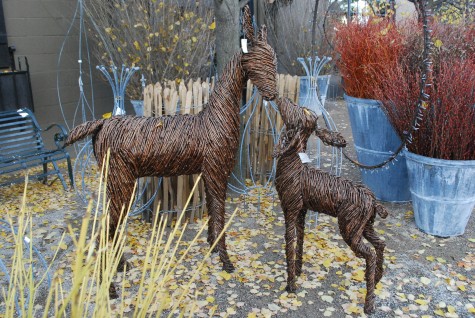 Grapes are a woody vine with long lax branches that can be shaped over forms. We have had on occasion grapevine wreaths, spheres, picture frames and nests-but these deer are the most elegant expression of weaving and sculpting with grapevine I have ever seen. The forms are heavy steel, and each vine is laid in parallel to its neighbor, and then woven into the whole figure. They look great paired with all of the twigs. The people who create these sculptures-artists, each and every one. They weld their frames, and weave the grapevine in a very individual way. This doe and fawn pair is distinctly the creation and look of the person who made them. My next pair will have a different look.
Grapes are a woody vine with long lax branches that can be shaped over forms. We have had on occasion grapevine wreaths, spheres, picture frames and nests-but these deer are the most elegant expression of weaving and sculpting with grapevine I have ever seen. The forms are heavy steel, and each vine is laid in parallel to its neighbor, and then woven into the whole figure. They look great paired with all of the twigs. The people who create these sculptures-artists, each and every one. They weld their frames, and weave the grapevine in a very individual way. This doe and fawn pair is distinctly the creation and look of the person who made them. My next pair will have a different look.
 The standing Buck is particularly handsome. Each antler has a steel pin that slides into a steel cylinder embedded behind the ears. The Buck stands almost 7 feet tall. This is my favorite species of deer for the garden!
The standing Buck is particularly handsome. Each antler has a steel pin that slides into a steel cylinder embedded behind the ears. The Buck stands almost 7 feet tall. This is my favorite species of deer for the garden!
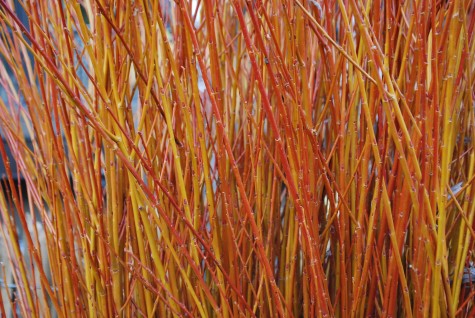 I can think of lots of places for the deer. As for the fresh cut twigs-what would you do with them?
I can think of lots of places for the deer. As for the fresh cut twigs-what would you do with them?
Deborah Silver is a landscape and garden designer whose firm, Deborah Silver and Co Inc, opened its doors in 1986. She opened Detroit Garden Works, a retail store devoted to fine and unusual garden ornament and specialty plants, in 1996. In 2004, she opened the Branch studio, a subsidiary of the landscape company which designs and manufactures garden ornament in a variety of media. Though her formal education is in English literature and biology, she worked as a fine artist in watercolor and pastel from 1972-1983. A job in a nursery, to help support herself as an artist in the early 80’s evolved into a career in landscape and garden design. Her landscape design and installation projects combine a thorough knowledge of horticulture with an artist’s eye for design. Her three companies provide a wide range of products and services to the serious gardener. She has been writing this journal style blog since April of 2009.
Copyright © 2025 · Deborah Silver & Co. · Detroit Garden Works